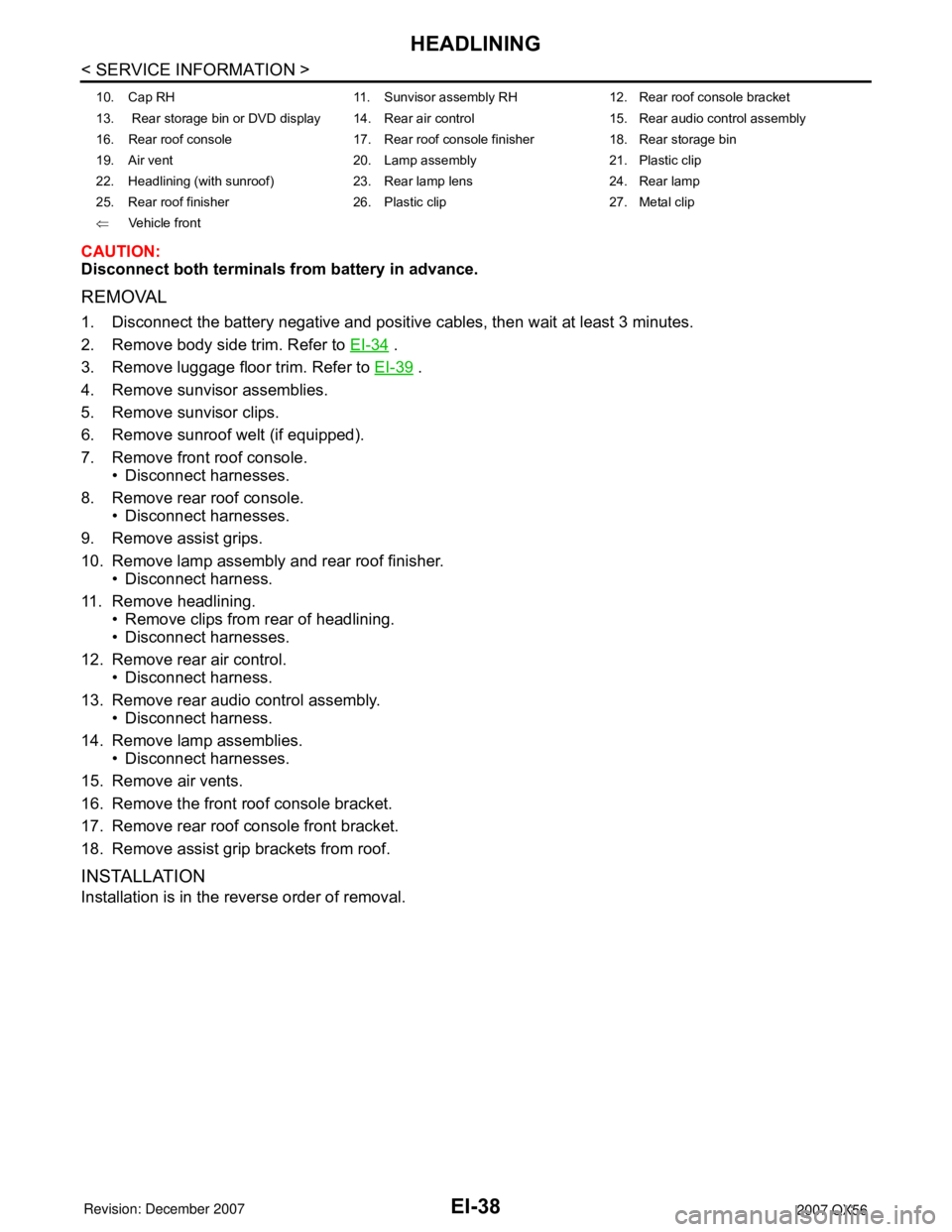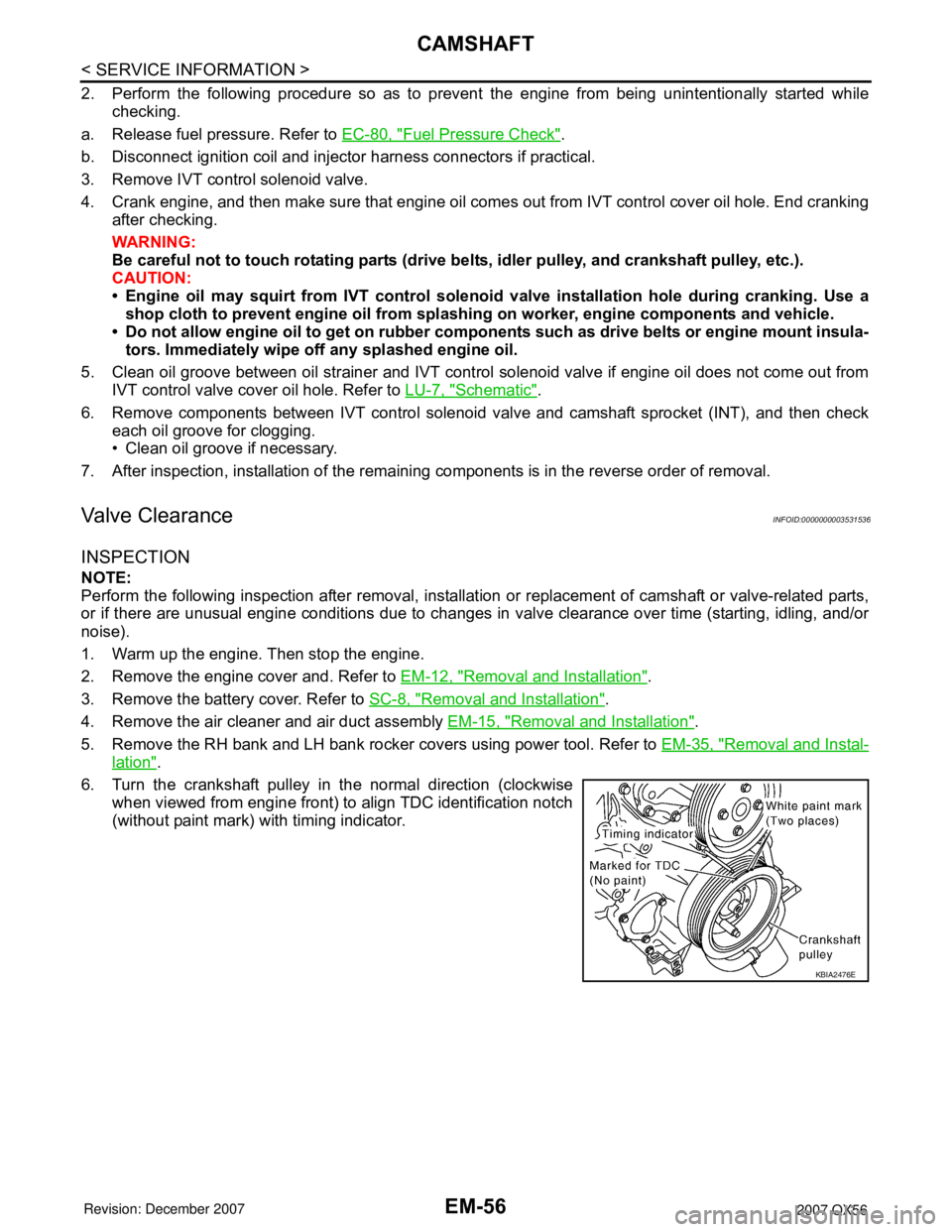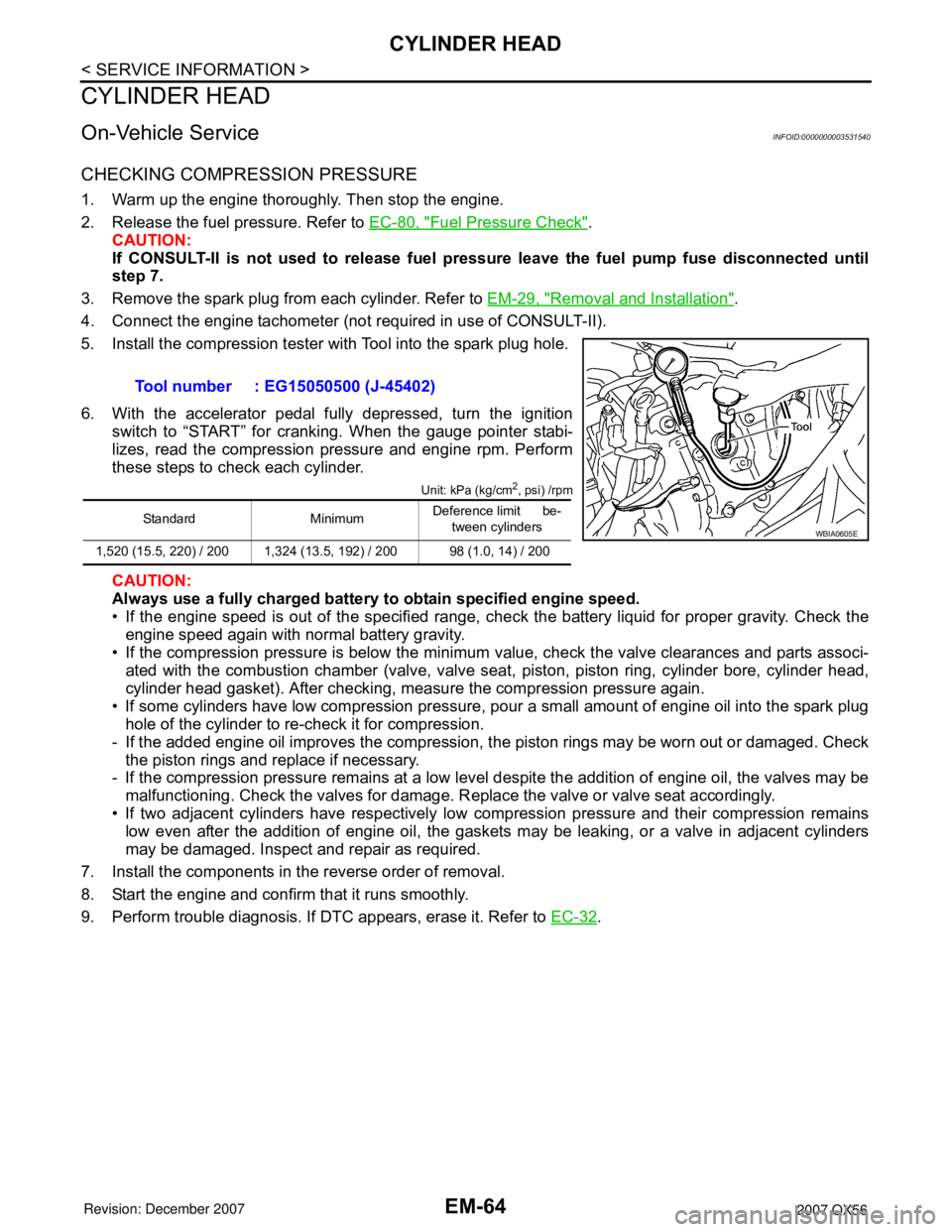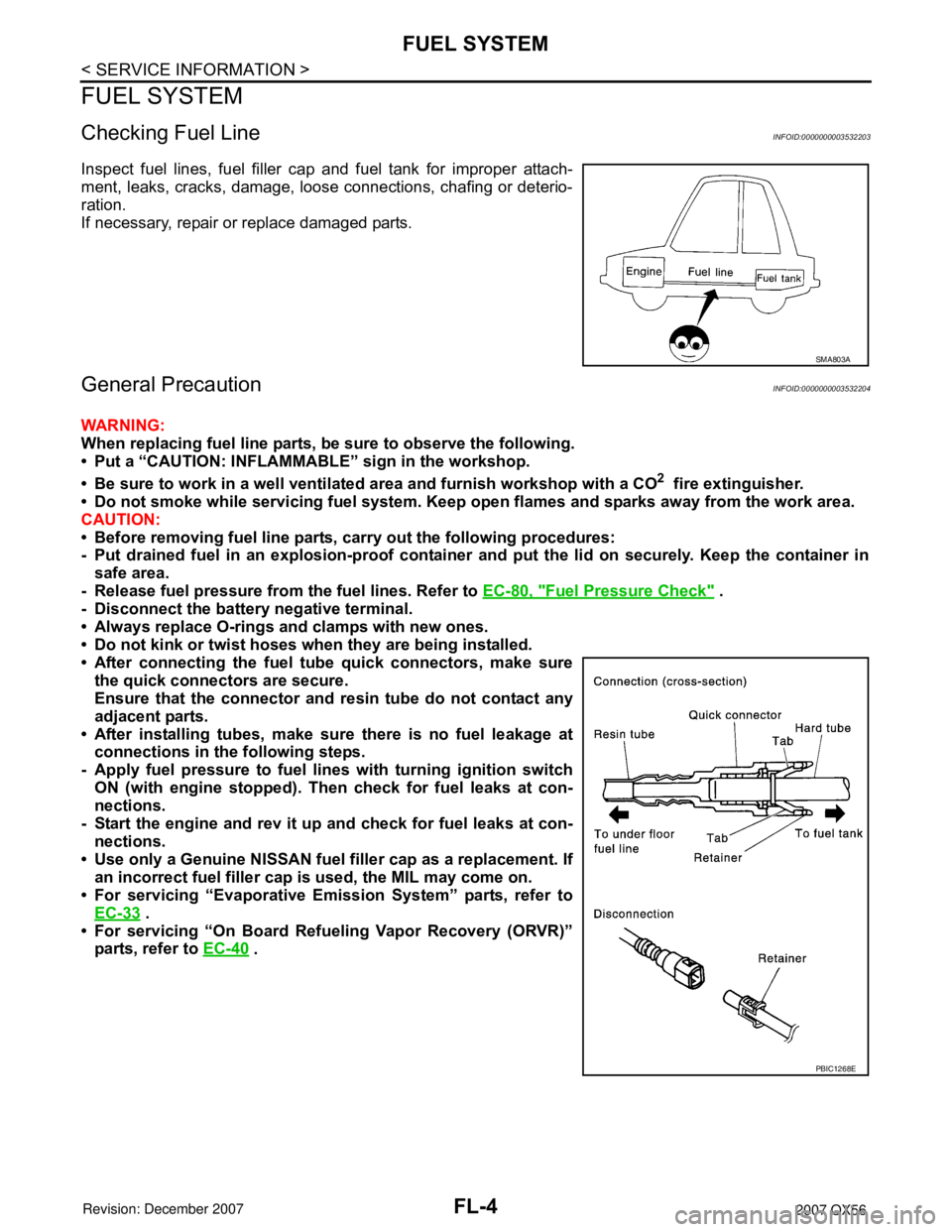Page 1756 of 3061
DOOR OUTSIDE MOLDING
EI-27
< SERVICE INFORMATION >
C
D
E
F
G
H
J
K
L
MA
B
EI
N
O
P
DOOR OUTSIDE MOLDING
Removal and InstallationINFOID:0000000003533133
Front Door
Removal
1. Open the front door and door window fully.
2. Remove the battery negative terminal.
3. Remove the door mirror. Refer to GW-84, "
Door Mirror Assembly".
4. Remove the front door outside molding.
• Remove the hole cover and remove screw.
• Lift the molding from rear edge first.
• Disconnect the clips from the flange working forward.
Installation
Installation is in the reverse order of removal.
WIIA0842E
Page 1760 of 3061
DOOR FINISHER
EI-31
< SERVICE INFORMATION >
C
D
E
F
G
H
J
K
L
MA
B
EI
N
O
P
DOOR FINISHER
Removal and InstallationINFOID:0000000003533135
Front Door
REMOVAL
1. Disconnect the negative battery cable.
2. Remove power window switch assembly.
• Disconnect harness connectors.
3. Remove pull handle cover.
• Remove screws behind pull handle cover.
4. Remove cap from pull handle escutcheon and remove screw.
5. Remove pull handle escutcheon.
• Remove screws behind pull handle escutcheon.
6. Remove armrest.
• Remove screw behind armrest.
7. Remove memory seat switch.
• Disconnect harness connector.
WIIA0965E
1. Power window switch assembly 2. Armrest 3. Front door finisher LH
4. Pull handle cover 5. Pull handle escutcheon 6. Cap
7. Door lock knob 8. Step lamp 9. Seat memory switch
Page 1761 of 3061
EI-32
< SERVICE INFORMATION >
DOOR FINISHER
8. Remove step lamp.
• Disconnect harness connector.
9. Remove door finisher and disconnect lock cable and handle cable from door handle assembly. Refer to
BL-110
.
10. Remove door lock knob.
INSTALLATION
Installation is in the reverse order of removal.
Rear Door
REMOVAL
1. Disconnect the negative battery cable.
2. Remove power window switch assembly.
• Disconnect harness connector.
3. Remove pull handle cover.
• Remove screws behind pull handle cover.
4. Remove cap from pull handle escutcheon and remove screw.
5. Remove pull handle escutcheon.
• Remove screws behind pull handle escutcheon.
WIIA0966E
1. Power window switch assembly 2. Armrest 3. Rear door finisher LH
4. Pull handle cover 5. Cap 6. Pull handle escutcheon
7. Door lock knob 8. Step lamp 9. Rear door tweeter
Page 1767 of 3061

EI-38
< SERVICE INFORMATION >
HEADLINING
CAUTION:
Disconnect both terminals from battery in advance.
REMOVAL
1. Disconnect the battery negative and positive cables, then wait at least 3 minutes.
2. Remove body side trim. Refer to EI-34
.
3. Remove luggage floor trim. Refer to EI-39
.
4. Remove sunvisor assemblies.
5. Remove sunvisor clips.
6. Remove sunroof welt (if equipped).
7. Remove front roof console.
• Disconnect harnesses.
8. Remove rear roof console.
• Disconnect harnesses.
9. Remove assist grips.
10. Remove lamp assembly and rear roof finisher.
• Disconnect harness.
11. Remove headlining.
• Remove clips from rear of headlining.
• Disconnect harnesses.
12. Remove rear air control.
• Disconnect harness.
13. Remove rear audio control assembly.
• Disconnect harness.
14. Remove lamp assemblies.
• Disconnect harnesses.
15. Remove air vents.
16. Remove the front roof console bracket.
17. Remove rear roof console front bracket.
18. Remove assist grip brackets from roof.
INSTALLATION
Installation is in the reverse order of removal.
10. Cap RH 11. Sunvisor assembly RH 12. Rear roof console bracket
13. Rear storage bin or DVD display 14. Rear air control 15. Rear audio control assembly
16. Rear roof console 17. Rear roof console finisher 18. Rear storage bin
19. Air vent 20. Lamp assembly 21. Plastic clip
22. Headlining (with sunroof) 23. Rear lamp lens 24. Rear lamp
25. Rear roof finisher 26. Plastic clip 27. Metal clip
⇐Vehicle front
Page 1801 of 3061
FUEL INJECTOR AND FUEL TUBEEM-31
< SERVICE INFORMATION >
C
DE
F
G H
I
J
K L
M A
EM
NP
O
FUEL INJECTOR AND FUEL TUBE
Removal and InstallationINFOID:0000000003531531
CAUTION:
Do not remove or disassemble parts unless instructed as shown.
REMOVAL
1. Remove the engine room cover using power tool. Refer to
EM-12, "Removal and Installation".
2. Release the fuel pressure. Refer to EC-80, "
Fuel Pressure Check".
3. Disconnect the negative battery terminal.
4. Disconnect the fuel injector harness connectors.
5. Disconnect the fuel hose assembly from the fuel tubes (RH and LH).
CAUTION:
• While hoses are disconnected, plug th em to prevent fuel from draining.
• Do not separate the fuel connector and fuel hose.
6. Remove the fuel injectors with the fuel tube assembly.
1. Fuel tube (RH) 2. Cap 3. Fuel damper
4. O-ring 5. O-ring (b lue) 6. Fuel injector
7. Clip 8. O-ring (brown) 9. O-ring
10. Fuel hose assembly 11. Fuel tube (LH)
KBIA2472E
Page 1826 of 3061

EM-56
< SERVICE INFORMATION >
CAMSHAFT
2. Perform the following procedure so as to prevent the engine from being unintentionally started while
checking.
a. Release fuel pressure. Refer to EC-80, "
Fuel Pressure Check".
b. Disconnect ignition coil and injector harness connectors if practical.
3. Remove IVT control solenoid valve.
4. Crank engine, and then make sure that engine oil comes out from IVT control cover oil hole. End cranking
after checking.
WARNING:
Be careful not to touch rotating parts (drive be lts, idler pulley, and crankshaft pulley, etc.).
CAUTION:
• Engine oil may squirt from IVT control soleno id valve installation hole during cranking. Use a
shop cloth to prevent engine oil from splashin g on worker, engine components and vehicle.
• Do not allow engine oil to get on rubber compon ents such as drive belts or engine mount insula-
tors. Immediately wipe off any splashed engine oil.
5. Clean oil groove between oil strainer and IVT control solenoid valve if engine oil does not come out from IVT control valve cover oil hole. Refer to LU-7, "
Schematic".
6. Remove components between IVT control solenoid va lve and camshaft sprocket (INT), and then check
each oil groove for clogging.
• Clean oil groove if necessary.
7. After inspection, installation of the remaining components is in the reverse order of removal.
Valve ClearanceINFOID:0000000003531536
INSPECTION
NOTE:
Perform the following inspection after removal, installation or replacement of camshaft or valve-related parts,
or if there are unusual engine conditions due to changes in valve clearance over time (starting, idling, and/or
noise).
1. Warm up the engine. Then stop the engine.
2. Remove the engine cover and. Refer to EM-12, "
Removal and Installation".
3. Remove the battery cover. Refer to SC-8, "
Removal and Installation".
4. Remove the air cleaner and air duct assembly EM-15, "
Removal and Installation".
5. Remove the RH bank and LH bank rocker covers using power tool. Refer to EM-35, "
Removal and Instal-
lation".
6. Turn the crankshaft pulley in the normal direction (clockwise when viewed from engine front) to align TDC identification notch
(without paint mark) with timing indicator.
KBIA2476E
Page 1834 of 3061

EM-64
< SERVICE INFORMATION >
CYLINDER HEAD
CYLINDER HEAD
On-Vehicle ServiceINFOID:0000000003531540
CHECKING COMPRESSION PRESSURE
1. Warm up the engine thoroughly. Then stop the engine.
2. Release the fuel pressure. Refer to EC-80, "
Fuel Pressure Check".
CAUTION:
If CONSULT-II is not used to release fuel pressure leave the fu el pump fuse disconnected until
step 7.
3. Remove the spark plug from each cylinder. Refer to EM-29, "
Removal and Installation".
4. Connect the engine tachometer (not required in use of CONSULT-II).
5. Install the compression tester with Tool into the spark plug hole.
6. With the accelerator pedal fully depressed, turn the ignition switch to “START” for cranking. When the gauge pointer stabi-
lizes, read the compression pressure and engine rpm. Perform
these steps to check each cylinder.
Unit: kPa (kg/cm2, psi) /rpm
CAUTION:
Always use a fully charged battery to obtain specified engine speed.
• If the engine speed is out of the specified range, che ck the battery liquid for proper gravity. Check the
engine speed again with normal battery gravity.
• If the compression pressure is below the minimum value, check the valve clearances and parts associ- ated with the combustion chamber (valve, valve seat , piston, piston ring, cylinder bore, cylinder head,
cylinder head gasket). After checking, measure the compression pressure again.
• If some cylinders have low compression pressure, pour a small amount of engine oil into the spark plug hole of the cylinder to re-check it for compression.
- If the added engine oil improves the compression, t he piston rings may be worn out or damaged. Check
the piston rings and replace if necessary.
- If the compression pressure remains at a low level despite the addition of engine oil, the valves may be
malfunctioning. Check the valves for damage. R eplace the valve or valve seat accordingly.
• If two adjacent cylinders have respectively low co mpression pressure and their compression remains
low even after the addition of engine oil, the gaskets may be leaking, or a valve in adjacent cylinders
may be damaged. Inspect and repair as required.
7. Install the components in the reverse order of removal.
8. Start the engine and confirm that it runs smoothly.
9. Perform trouble diagnosis. If DTC appears, erase it. Refer to EC-32
.
Tool number : EG15050500 (J-45402)
Standard Minimum
Deference limit be-
tween cylinders
1,520 (15.5, 220) / 200 1,324 (13.5, 192) / 200 98 (1.0, 14) / 200WBIA0605E
Page 1935 of 3061

FL-4
< SERVICE INFORMATION >
FUEL SYSTEM
FUEL SYSTEM
Checking Fuel LineINFOID:0000000003532203
Inspect fuel lines, fuel filler cap and fuel tank for improper attach-
ment, leaks, cracks, damage, loose connections, chafing or deterio-
ration.
If necessary, repair or replace damaged parts.
General PrecautionINFOID:0000000003532204
WARNING:
When replacing fuel line parts, be sure to observe the following.
• Put a “CAUTION: INFLAMMABLE” sign in the workshop.
• Be sure to work in a well ventilated area and furnish workshop with a CO
2 fire extinguisher.
• Do not smoke while servicing fuel system. Keep open flames and sparks away from the work area.
CAUTION:
• Before removing fuel line parts, carry out the following procedures:
- Put drained fuel in an explosion-proof container and put the lid on securely. Keep the container in
safe area.
- Release fuel pressure from the fuel lines. Refer to EC-80, "
Fuel Pressure Check" .
- Disconnect the battery negative terminal.
• Always replace O-rings and clamps with new ones.
• Do not kink or twist hoses when they are being installed.
• After connecting the fuel tube quick connectors, make sure
the quick connectors are secure.
Ensure that the connector and resin tube do not contact any
adjacent parts.
• After installing tubes, make sure there is no fuel leakage at
connections in the following steps.
- Apply fuel pressure to fuel lines with turning ignition switch
ON (with engine stopped). Then check for fuel leaks at con-
nections.
- Start the engine and rev it up and check for fuel leaks at con-
nections.
• Use only a Genuine NISSAN fuel filler cap as a replacement. If
an incorrect fuel filler cap is used, the MIL may come on.
• For servicing “Evaporative Emission System” parts, refer to
EC-33
.
• For servicing “On Board Refueling Vapor Recovery (ORVR)”
parts, refer to EC-40
.
SMA803A
PBIC1268E